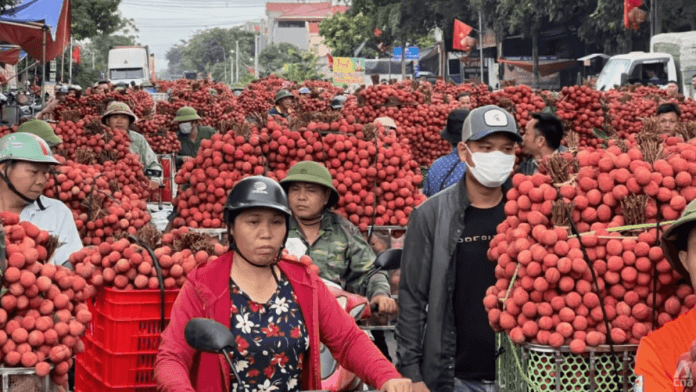News in Brief:
– Vietnam’s lychee production drops by 50%, leading to soaring prices due to adverse weather.
– Despite these production challenges, high demand from China continues to offer opportunities for Vietnamese farmers.
Vietnam’s lychee farmers are grappling with a paradox: a significant drop in production and soaring prices. This year, the adverse weather conditions that affected China’s lychee crop have similarly impacted Vietnam’s Bac Giang province, the heart of the country’s lychee cultivation. The resulting 50% decrease in lychee output has had a profound impact on farmers and the market.
Bac Giang, which usually produces 200,000 metric tons of lychees annually, is expected to yield only 100,000 metric tons this year. Despite the reduced supply, robust demand from China has pushed prices higher. Farmers now sell grade 1 lychees at nearly 60,000 Vietnamese dong ($2.36) per kilogram, compared to 40,000–45,000 dong ($1.57–1.77) last year. For many small-scale farmers, this price surge offers a glimmer of hope amidst the production crisis.
China’s insatiable demand continues to be the main driver of these price hikes. In 2023, 55.1% of Bac Giang’s lychee output was exported, with over 98% going to China. This year, even with the reduced harvest, Chinese traders have flocked to the region, eager to secure their share. Nguyen Van Hai, vice chairman of Luc Ngan County’s People’s Committee, confirms that the early-season lychee harvest has begun, with farm gate prices hovering around 50,000 dong ($1.96) per kilogram.
Challenges and diversification opportunities
For many Vietnamese lychee farmers, the increased prices do not entirely offset the challenges posed by reduced yields. In Huyen Thanh County, Hai Duong province, known as the “lychee capital” of Vietnam, production has also halved, expected to be just over 20,000 metric tons. However, the silver lining is that the quality of lychees has improved, and prices are anticipated to rise by 10–20%.
In the face of these challenges, farmers and traders are adapting. This year, Hai Duong’s lychees are being exported to new markets including Australia, France, Thailand, Singapore, and Canada. Diversifying export destinations may provide a buffer against future market volatility and help stabilise incomes for farmers.
For aspiring farmers, the current scenario highlights the importance of understanding market dynamics and weather dependencies. While high prices can be enticing, the volatility in production underscores the need for resilience and adaptive strategies. Exploring diversified crops and markets, investing in quality improvements, and staying informed about global demand trends are critical steps for success in the agricultural sector.



